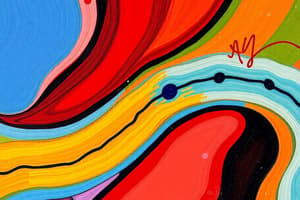Podcast
Questions and Answers
What role does myoglobin play in muscle tissue?
What role does myoglobin play in muscle tissue?
- It generates ATP.
- It transports carbon dioxide.
- It acts as an oxygen transporter. (correct)
- It stores carbohydrates.
Which statement is true about the structure of myoglobin?
Which statement is true about the structure of myoglobin?
- Myoglobin contains no prosthetic groups.
- Myoglobin is a monomeric helical protein. (correct)
- Myoglobin is made up of multiple polypeptide chains.
- Myoglobin has two heme groups.
What is the significance of the heme molecule being sequestered from water in myoglobin?
What is the significance of the heme molecule being sequestered from water in myoglobin?
- It prevents the release of oxygen.
- It helps maintain iron in the +2 state. (correct)
- It enhances the protein's solubility in water.
- It allows for the binding of carbon dioxide.
How does myoglobin's structure change upon oxygen binding?
How does myoglobin's structure change upon oxygen binding?
What distinguishes oxygenation from oxidation in the context of myoglobin?
What distinguishes oxygenation from oxidation in the context of myoglobin?
What is methemoglobinemia?
What is methemoglobinemia?
What characterizes the heme group in myoglobin and hemoglobin?
What characterizes the heme group in myoglobin and hemoglobin?
Which of the following statements about the structure of hemoglobin is correct?
Which of the following statements about the structure of hemoglobin is correct?
What is the molecular defect in HbS?
What is the molecular defect in HbS?
Which treatment option focuses on stimulating the production of HbF?
Which treatment option focuses on stimulating the production of HbF?
Why do individuals with heterozygous sickle cell anemia have partial resistance to malaria?
Why do individuals with heterozygous sickle cell anemia have partial resistance to malaria?
What is the phenotype of individuals who are heterozygous for sickle cell anemia?
What is the phenotype of individuals who are heterozygous for sickle cell anemia?
What occurs when HbS is in its deoxy form?
What occurs when HbS is in its deoxy form?
What is the primary function of myoglobin?
What is the primary function of myoglobin?
Which of the following statements about hemoglobin is accurate?
Which of the following statements about hemoglobin is accurate?
What does a Hill coefficient greater than 1 indicate about hemoglobin's oxygen binding?
What does a Hill coefficient greater than 1 indicate about hemoglobin's oxygen binding?
What is the effect of BPG on fetal hemoglobin?
What is the effect of BPG on fetal hemoglobin?
Which of the following is a consequence of sickle cell anemia?
Which of the following is a consequence of sickle cell anemia?
What type of mutations in hemoglobin may have no impact on its function?
What type of mutations in hemoglobin may have no impact on its function?
What results from the presence of methemoglobin?
What results from the presence of methemoglobin?
Which of the following compounds act as negative allosteric effectors for hemoglobin?
Which of the following compounds act as negative allosteric effectors for hemoglobin?
Study Notes
Myoglobin
- Myoglobin is a monomeric helical protein containing a heme molecule that transports oxygen in muscle tissue.
- The heme is sequestered in a non-polar pocket, protecting the iron (Fe) from oxidation and maintaining it in the +2 state.
- Oxygenated myoglobin appears bright red; oxidized myoglobin is brownish, and deoxygenated myoglobin has a bluish hue.
- A proximal histidine acts as a ligand to iron and undergoes a structural change during oxygenation.
Hemoglobin Structure and Function
- Hemoglobin (HbA) consists of two alpha (α) and two beta (β) subunits, forming a dimer that also contains heme.
- Myoglobin is located in muscle, while hemoglobin is found in blood.
- The Hill plot indicates cooperativity; n > 1 signifies positive cooperativity in ligand binding.
- CO2, H+, and BPG act as negative allosteric effectors, reducing hemoglobin's affinity for oxygen.
- Fetal hemoglobin (HbF) is composed of two alpha (α) and two gamma (γ) subunits, which bind BPG less effectively.
Diseases of Hemoglobin
- Various mutations in Hemoglobin A can lead to functional changes; some mutations, like Hemoglobin S (HbS), are pathologically significant.
- Sickle cell anemia is characterized by sickled red blood cells due to insoluble hemoglobin (HbS), leading to blockage in capillaries and organ damage.
- Individuals can be homozygous (SS) or heterozygous (AS) for the sickle cell trait, with approximately 1 in 13 African-Americans being heterozygous and 1 in 365 having sickle cell disease in the U.S.
- The molecular defect in HbS is a point mutation that changes glutamate to valine on the β subunit's exterior, affecting its charge and solubility.
- Symptoms of sickle cell anemia manifest after birth and can be diagnosed via electrophoresis.
- Decreased oxygen increases sickling; both HbA and HbS exhibit structural changes in deoxy forms, leading to polymer formation in HbS.
Treatment of Sickle Cell Anemia
- Treatment includes antibiotic therapy to prevent infections, hydroxyurea to stimulate production of fetal hemoglobin (HbF), and bone marrow transplantation for replacement of HbS with HbA.
- Gene therapy is currently in clinical trials (Phase I/II).
- Individuals with heterozygous sickle cell anemia exhibit partial resistance to malaria, attributed to the structural changes in hemoglobin affecting the malaria parasite's lifecycle.
Studying That Suits You
Use AI to generate personalized quizzes and flashcards to suit your learning preferences.
Related Documents
Description
Explore the fundamental concepts of oxygen transporters in this quiz focusing on myoglobin and hemoglobin. Understand their structures, functions, and related diseases such as methemoglobinemia and sickle-cell anemia. Perfect for medical students and anyone interested in human physiology.



